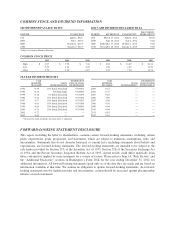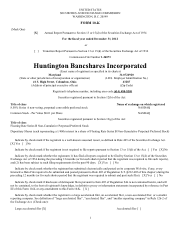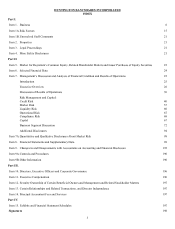Huntington National Bank 2012 Annual Report Download - page 18
Download and view the complete annual report
Please find page 18 of the 2012 Huntington National Bank annual report below. You can navigate through the pages in the report by either clicking on the pages listed below, or by using the keyword search tool below to find specific information within the annual report.10
In mid-January 2013, the CFPB issued eight final regulations governing consumer mortgage lending. The first of these rules was
issued on January 10, 2013, and included the ability to repay and qualified mortgage rule. This rule will impose additional
requirements on lenders, including rules designed to require lenders to ensure borrowers’ ability to repay their mortgage. The same
day, the CFPB also finalized a rule on escrow accounts for high-cost mortgages and a rule expanding the scope of the high-cost
mortgage provision in the Truth in Lending Act. On January 17, 2013, the CFPB issued its final rules implementing provisions of the
Dodd-Frank Act that relate to mortgage servicing, which will take effect on January 10, 2014. On January 18, 2013, the CFPB issued
a final appraisal rule under the Equal Credit Opportunity Act and six agencies including the CFPB, FRB, OCC, FDIC, NCUA, and
FHFA issued an interagency rule on appraisals for higher-priced mortgage loans. A final rule on loan originator compensation was
released on January 20, 2013, and the industry expects a final rule on integrated mortgage disclosures within the next year. We are
evaluating these rules to determine their impact on the Bank and its affiliates.
Our Tier 1 risk-based capital will be negatively impacted by the Collins Amendment provisions of the Dodd-Frank Act.
The Collins Amendment provision of the Dodd-Frank Act imposes increased capital requirements in the future. The Collins
Amendment also requires federal banking regulators to establish minimum leverage and risk-based capital requirements to apply to
insured depository institutions, bank and thrift holding companies, and systemically important nonbank financial companies. These
capital requirements must not be less than the Generally Applicable Risk Based Capital Requirements and the Generally Applicable
Leverage Capital Requirements as of July 21, 2010, and must not be quantitatively lower than the requirements that were in effect for
insured depository institutions as of July 21, 2010. The Collins Amendment defines Generally Applicable Risk Based Capital
Requirements and Generally Applicable Leverage Capital Requirements to mean the risk-based capital requirements and minimum
ratios of Tier 1 risk-based capital to average total assets, respectively, established by the appropriate federal banking agencies to apply
to insured depository institutions under the Prompt Corrective Action provisions, regardless of total consolidated asset size or foreign
financial exposure. Over a three year phase-out period, trust preferred securities will no longer qualify as Tier 1 risk-based capital for
certain bank holding companies, including us. The Collins Amendment stipulates that this phase out period begins in 2013. We have
plans in place, including trust preferred securities redemption, to minimize the impact of this amendment on us.
Large bank holding companies are now required to submit annual capital plans to the Federal Reserve and conduct stress tests.
The Federal Reserve published final amendments to Regulation Y to require large bank holding companies to submit capital plans
to the Federal Reserve on an annual basis and to require such bank holding companies to obtain approval from the Federal Reserve
under certain circumstances before making a capital distribution. This rule applies to us and all other bank holding companies with
$50 billion or more of total consolidated assets. The first capital plans required under these rules were due on January 9, 2012. Capital
plans for 2013 were required to be submitted on January 7, 2013. A large bank holding company’s capital plan must include an
assessment of the expected uses and sources of capital over at least the next nine quarters, a description of all planned capital actions
over the planning horizon, a detailed description of the entity’s process for assessing capital adequacy, the entity’s capital policy, and
a discussion of any expected changes to the banking holding company’s business plan that are likely to have a material impact on the
firm’s capital adequacy or liquidity. The Federal Reserve will either object to a capital plan, in whole or in part, or provide a notice of
non-objection no later than March 31, 2013, for plans submitted by the January 7, 2013 submission date. If the Federal Reserve
objects to a capital plan, the bank holding company may not make any capital distribution other than those with respect to which the
Federal Reserve has indicated its non-objection. While we can give no assurances as to the outcome or specific interactions with the
regulators, based on the Capital Plan we submitted on January 7, 2013, we believe we have a strong capital position.
The Federal Reserve, FDIC, and OCC banking regulators issued proposed rules to implement section 165 of the Dodd-Frank Act
which requires financial institutions with total consolidated assets of more than $10 billion ("covered banks") to conduct certain stress
tests on an annual basis. The Federal Reserve issued their final capital plan rule in late 2011 and updated instructions in November of
2012 for BHCs that did not participate in the 2009 Supervisory Capital Assessment, but are required to submit under the capital plan
rule as part of the annual Capital Plan Review (CapPR 2013). Huntington participated as a CapPR BHC in 2012 and 2013. The
Dodd-Frank Act requires these regulations to define the term "stress test"; establish methodologies for the conduct of the stress tests
that measure the Tier 1 common risk-based capital ratio under at least three different sets of conditions, including baseline, adverse,
and severely adverse conditions; establish the form and content of a required regulatory report on the stress tests; and require covered
banks to publish a summary of the results of their stress tests. For the purposes of the CapPR 2013, BHCs were required to submit the
results of stress tests based on two supervisory scenarios, at least one stressed scenario developed by the BHC, and a BHC baseline
scenario. We submitted our capital plan to the Federal Reserve on January 7, 2013, which included the impact to Tier 1 common risk-
based capital and total risk-based capital ratios.
The regulatory capital rules indicate that common stockholders’ equity should be the dominant element within Tier 1 capital and
that banking organizations should avoid overreliance on non-common equity elements. Under the Dodd-Frank Act, the ratio of Tier 1
common equity to risk-weighted assets became significant as a measurement of the predominance of common equity in Tier 1 capital
and an indication of the quality of capital.
























